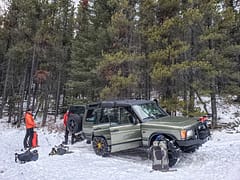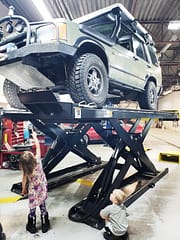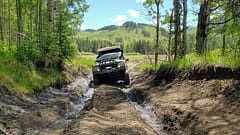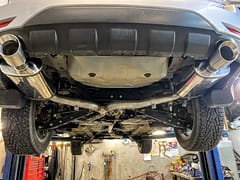Land Rover Discovery Engine Re-build and Replacement
Experience and recommendations for Discovery 2 engines
Contents
- Introduction
- Our Land Rover Engine
- First Head Gasket Rebuild
- Second Head Gasket Rebuild
- How to Test for Over Pressurization?
- Now what to do…
- Aftermarket Gauges
- ECU (Engine Control Unit / ECM Engine Control Module)
Introduction
We love our Land Rover, it has become a part of our family. Our Land Rover takes us to our outdoor destinations and the drive is usually it’s own adventure. We are grateful to be able to explore with a vehicle that has the ability to get off-road and see places many people don’t have access to. Our love for our Land Rover is partially due to the sweat, blood and tears we have poured into it. The most significant issue we have had is the engine. Here is how we made our Land Rover’s heart work again.
Our Land Rover Engine
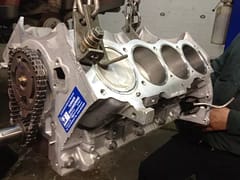
Third time’s a charm right? At least in the case of our engine. When in doubt look to England, the Motherland of Rover’s really might know best. Here is our story about going through two engine rebuilds and finally a replacement. We hope this information can help others in their decisions on engine repair vs replacement.
We have a 2001 Land Rover Discovery 2, it had its original engine when we purchased it in 2010. We describe our engine through the timeline of our ownership. You know you have had your Discovery for a while when you think of the engine as a timeline of rebuilds and engine swaps. Our Rover was a 2001 Land Rover Discovery 2 V8 4.0 without Secondary Air Injection.
Now the engine is a Turner Engineering built 4.6 V8 with high performance Kent camshaft gas flowed intake and exhaust manifolds with air intake and MAF upgraded to 4.6 specifications. The upgraded engine has had its ECU reprogrammed by sending the unit to Mark Adams at Tornado Systems in the UK.
Video that summarizes the Engine upgrades and a rip in our Rover
First Head Gasket Rebuild
Symptom: Leaking head gasket
Work Performed:
- Power Steering pump replaced
- Timing chain cover and chain replaced
- Water pump and gasket replaced
- Leaking head gasket replaced
- Oil pan gasket replaced
- Rear main seal replaced
Second Head Gasket Rebuild
Symptom: Head gasket started failing and replaced again
Work Performed:
- Ported and polished intake and exhaust manifold.
- Installed Magnaflow exhaust.
- Cat bypass using spark plug non-fowlers for rear O2 sensors.
Had issues with coolant getting air in system. Persistent overflow issues from overflow tube coming out of expansion reservoir and expansion tank cap leaking. Replaced cap which simply forced more coolant out of overflow tube generally after driving. This would occur once stopped after driving with the engine off then the coolant tank would fill back up. All coolant hoses were also found to be extremely firm when running which helped lead to the conclusion of air getting into system.
Instead of disassembling the engine only to find what was likely slipped liners or a crack in the block or both, an engine swap was determined as next course of action. Rebuilt P38 / Range Rover 4.6 was determined to be used as the new engine while still allowing for use of the ported and polished intake and exhaust manifolds. Engine had been pressure tested by a local machine shop. Unfortunately, this was done with the liners in place. Upon reassembling and starting the truck gave there was some good news and some bad news.
- The good news was that the truck had tons of power.
- The bad news was that the system had already begun to over pressurize. This was a result of crack in the sleeve / block.
This was not found during the pressure test of the block prior to assembly due to the fact that heat cannot be applied to the block during pressure test. Cracks and holes can be missed and only appear when the engine is running.
How to Test for Over Pressurization?
One way to confirm over pressurization is an Engine Combustion Leak Test. This is a fairly simple solution you can do yourself. This test uses a solution to determine if CO2 (exhaust gas) is present in the coolant. The CO2 can only come from the combustion system and indicates a crack in the block and/or slipped liner. The solution changes colour if CO2 is present. After performing this test it became clear that CO2 was present. Image below is of the test and colour change to confirm over pressurization.
Head Gasket Combustion Leak Test
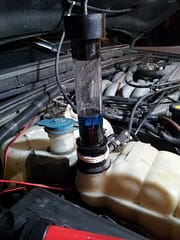
Now what to do…
Build another engine?
If this was going to happen it would mean factoring in top hat liners, after this experience and a ton of research top hat liners as this was clearly the generally accepted solution. Next question was how to get an engine with top hat liners?
Option 1) Build it yourself by bringing in just the liners and finding a good block having it pressure tested. Then having the top hat liners installed using heat and having each liner honed. Risk with this option was the machine shop would be experimenting to do this and they would also have to machine a lip around the top of each cylinder to allow the top hat liners to seat. This seemed too risky and just as expensive as option 2.
Option 2) Buy a pre-built short block with cylinder head top hat liners from one of the handful Land Rover V8 specialists in the UK or US (I’m in Canada).
Here are the Land Rover V8 specialists I found with top hat liners:
- Atlantic British
- Turner Engineering
- RPi Engineering
Purchasing top hat liners (ours has Darton) seemed like the best option as it meant getting a product from individuals that specialized in the specific task of rebuilding Rover engines. We followed the old expression that people that do the best work do one thing and do it well. After watching a lot of YouTube videos and reading a ton of forums I decided to go with a company named Turner Engineering. Turner seemed to have a stellar reputation for attentive customer service and quality work. This turned out to be true in all regards. There were not many options for us to choose from when we did this, there are more options now - do your research and choose what will work best for you.
The communication which was kept up to inform me of all my UK to Canada shipping and nervous engine purchasing questions was greatly appreciated. As my wife and I were about to invest a large amount of money into buying a new heart for our beast we decided to opt for the cheaper shipping. Despite being around $500 cheaper it did take a painfully long amount of time with DHL shipping company. We had a better experience shipping our ECU to the UK from Canada using UPS though the ECU is smaller and we paid for express shipping. I have heard more stories of UPS dealing with cross border customs duties much more seamlessly. At the end of the engine shipping the result was a nicely crated engine with the additionally order parts of a high performance Kent Camshaft and axillary shims to allow for refitting.
Engine Arrived!
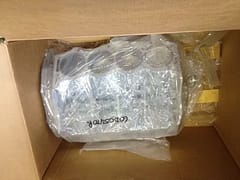
Close Up of the Top Hat Liners
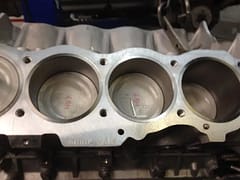
Aftermarket Gauges
When the engine was installed I wanted to put some aftermarket gauges in the truck to ensure all the vitals could be tracked real time going forward. A nice set of auto meter gauges were installed including a volt meter, oil pressure gauge and engine temperature gauge.
Volt Gauge
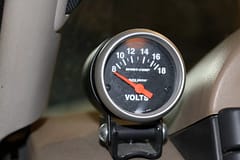
Water and Oil Gauge
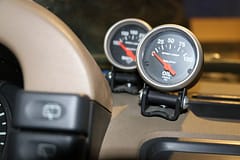
I should mention that all of the work done on this truck was done by a shop in Calgary Alberta called TRS Automotive. Needless to say we’ve learned a lot together. Since our experience one of friends with a 2002 Land Rover Discovery has had their engine replaced with an engine built from the ground up with cylinder top hat liners from Turner Engineering.
When the Turner 4.6 engine was first installed it was mated to the original 4.0 air box and MAF. Despite this fact the engine produced strong performance. Low end torque was beautiful. After driving in the mountains it did seem like there was still some untapped power. Going up mountain roads at 100-120 KPH it wasn’t as fast as I would like. Apparently this is where you might see a slight difference between a 4.6 built with 4.0 pistons which have a certain cup dimension vs a 4.6 built with the original 4.6 cups. As I have been told the original 4.6 pistons give better top end performance where the 4.0 pistons will give better low end performance.
ECU (Engine Control Unit / ECM Engine Control Module)
The next step in engine performance was to change the air box, Mass Air Flow Sensor (MAF) and intake to throttle body hose to the 4.6 engine specifications.
I bought a new MAF, got a hold of a second hand MAF (for testing purposes) and found a used 4.6 air box and intake to throttle body hose which I used for the engine specification changes. Upon installing the 4.6 air assembly the engine again had a increase in power. Unfortunately this came with the triggering of lean fuel codes from the ECU which was not mapped for a 4.6 MAF (was still mapped for 4.0 MAF). In order to prevent issues with the engine running lean and possibly overheating pistons the ECU was sent to Mark Adams at Tornado Systems International in the UK to be reprogrammed with a dyno optimized 4.6 fuel map. Shipping the ECU through UPS (Canada to UK and back) it took 9 days including the work! Whoot! Prior to reinstalling the ECU there was quite a bit of excitement to find out if the reprogrammed ECU would work. This anxiety was far less then it would have been if I had not spoken directly to the friendly Mark Adams regarding the numerous ECU reprograms beneath his belt and coordinated around the world.
Once I put the reprogrammed ECU in the engine started and idled beautifully. Pulling out of the garage and taking off for the first test drive immediately yielded strong torque and precise throttle response. Taking the Rover on the highway proved to support Mark Adams’ statements around improving the frequently discussed lack of power after 3000RPM.
The Disco is now FAST and dare I say the performance modifications are COMPLETE!?! Who would have thought passing uphill in a Disco would feel easy!

